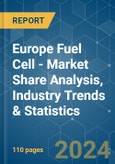The Europe Fuel Cell Market size is estimated at USD 2.52 billion in 2024, and is expected to reach USD 9.75 billion by 2029, growing at a CAGR of 31.01% during the forecast period (2024-2029).
The Europe's fuel cell market is estimated to be at USD 1.92 billion by the end of this year and is projected to reach USD 7.44 bllion in the next five years, registering a CAGR of over 31.01% during the forecast period.
This product will be delivered within 2 business days.
The Europe's fuel cell market is estimated to be at USD 1.92 billion by the end of this year and is projected to reach USD 7.44 bllion in the next five years, registering a CAGR of over 31.01% during the forecast period.
Key Highlights
- Over the medium term, the increasiduring the forecasted period.
- Nevertheless, the increasing focus on hydrogen production and infrastructure development is expected to create huge opportunities for the Europe fuel cell market.
- Germany is expected to play a major role in the fuel cell market in Europe. Germany has been a leading country in promoting fuel cell technology and has implemented various policies and initiatives to support its adoption.
Europe Fuel Cell Market Trends
Transportation Sector Expected to Dominate the Market
- Fuel cells are particularly suitable for heavy-duty transportation applications such as buses, trucks, and trains. These vehicles typically have higher energy demands and longer operating ranges, making them challenging for purely battery-electric solutions. Fuel cells can provide the required power and range while offering zero-emission operation.
- The transportation sector is a significant contributor to greenhouse gas emissions, and there is a growing global commitment to decarbonize this sector. Fuel cells offer a zero-emission alternative to internal combustion engines, making them an attractive solution for reducing carbon emissions from transportation.
- Although the growth in the number of fuel-cell electric vehicles in the region is meager, according to Fuel Cells and Hydrogen Observatory majority of fuel-cell electric vehicles registered in 2022 was in Germany 34 compared to only 1 in the United Kingdom and Spain, signifying the adoption of these vehicles is in early stages and has a significant market opportunity for growth.
- Moreover, fuel cells have the advantage of utilizing existing infrastructure. Hydrogen fueling stations can be integrated into existing gas stations, allowing for a relatively faster rollout of refueling infrastructure compared to widespread electric charging infrastructure.
- Additionally, in February 2023, Europe officially confirmed the prohibition on selling new petrol and diesel cars starting in 2035. As the world's second-largest car market, this decision follows the passing of a law by the European Parliament mandating car manufacturers to achieve complete elimination of CO2 emissions from all newly produced vehicles. This is expected to increase the sales of fuel-cell electric vehicles during the forecasted period.
- Therefore, per the points mentioned above, the transportation sector is expected to dominate the market during the forecasted period.
Germany Expected to Dominate the Market
- Germany is expected to play a major role in the fuel cell market in Europe. Germany has been a leading country in promoting fuel cell technology and has implemented various policies and initiatives to support its adoption. The German government has set ambitious targets for hydrogen and fuel cell deployment and has allocated significant funding for research, development, and commercialization of fuel cell technologies.
- Germany has a well-developed industrial base and strong manufacturing capabilities, which can support the production and deployment of fuel cell systems. The country is home to several prominent fuel cell manufacturers, research institutions, and industry associations that contribute to technological advancements and market growth.
- Furthermore, Germany's commitment to renewable energy and decarbonization efforts aligns with the potential of fuel cells as a clean and sustainable energy solution. The country's transition to renewable energy sources, particularly wind and solar, can be complemented by integrating fuel cells for efficient energy conversion and storage.
- Additionally, Germany has ambitious plans to develop a comprehensive hydrogen infrastructure, including hydrogen production facilities and refueling stations. This infrastructure is vital for the widespread adoption of fuel-cell vehicles and other hydrogen-based applications. Germany's commitment to hydrogen infrastructure development positions it as a leader in fuel cell deployment.
- According to the H2 stations organization, the number of hydrogen refueling stations has increased significantly in Germany in recent years. In 2022, the country's total number of hydrogen refueling stations was 104 compared to 65 in 2018.
- In January 2023, the hydrogen refueling station at Tempelhofer Weg 102 in Berlin, operated by H2 MOBILITY Germany, officially opened. This station is expected to cater to the refueling needs of hydrogen-powered vehicles, including fuel cell trucks, waste collectors, cars, and light commercial vehicles. Notably, the Tempelhofer Weg station boasts a high storage capacity of over 850 kilograms of hydrogen, making it one of Europe's most efficient hydrogen stations. This station's successful operation is crucial for advancing and expanding hydrogen-powered mobility in the capital city.
- Therefore, as discussed above, Germany is expected to dominate the market during the forecasted period.
Europe Fuel Cell Industry Overview
Europe's fuel cell market is semi fragmanted. Some of the key players in this market (not in particular order) include Ballard Power System Inc, Toshiba Corp, Fuelcell Energy Inc, Plug Power Inc, and Nuvera Fuel Cell LLC.Additional Benefits:
- The market estimate (ME) sheet in Excel format
- 3 months of analyst support
This product will be delivered within 2 business days.
Table of Contents
1 INTRODUCTION
4 MARKET OVERVIEW
5 MARKET SEGMENTATION
6 COMPETITIVE LANDSCAPE
7 MARKET OPPORTUNITIES AND FUTURE TRENDS
Companies Mentioned (Partial List)
A selection of companies mentioned in this report includes, but is not limited to:
- Ballard Power System Inc.
- Toshiba Corp.
- Fuelcell Energy Inc.
- Nuvera Fuel Cells LLC
- Plug Power Inc.
- AFC Energy
- Topsoe
- Ceres Power
- SFC Energy
- Cummins Inc.
Methodology

LOADING...










